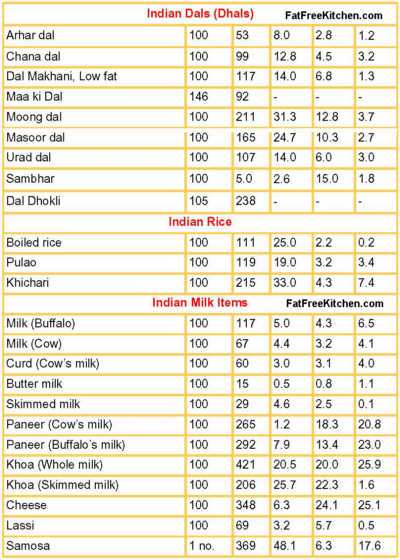Indian Food Calorie Counter Biography
Source(google.com.pk)
The energy stored in food is measured in terms of calories.
Technically, 1 calorie is the amount of energy required to raise the temperature of 1 gram of water 1 degree centigrade. The calorie measure used commonly to discuss the energy content of food is actually a kilocalorie or 1000 real calories. This is the amount of energy required to raise 1 kilogram of water (about 2.2 pounds) 1 degree centigrade.
Different foods contain different amounts of energy -- which is why a small piece of chocolate can have many more calories than a similarly sized piece of lettuce.
However, since calories are a measure of energy, there cannot be, as some diet books claim, different types of calories. A fat calorie has the same amount of energy as a protein or carbohydrate calorie.
A person's caloric need is determined using a variety of mathematical equations. Age, height, current weight, and desired weight are taken into account. Diet is what you eat. Dieting usually refers to eating fewer calories to lose weight.
The amount of calories in a diet refers to how much energy the diet can provide for the body. A well-balanced diet is one that delivers an adequate amount of calories while providing the maximum amount of nutrients.
The body breaks down food molecules to release the energy stored within them. This energy is needed for vital functions like movement, thought, growth -- anything that you do requires the use of fuel. The body stores energy it does not need in the form of fat cells for future use.
The process of breaking down food for use as energy is called metabolism. Increased activity results in increased metabolism as the body needs more fuel. The opposite is also true. With decreased activity the body continues to store energy in fat and does not use it up. Therefore, weight gain is the result of increased intake of food, decreased activity, or both.
The nutrition labels on food packages indicate the number of calories contained in the food.
Back to TopFood Sources
Naturally, different foods provide different amounts of calories. Some foods, such as ice-cream, have many calories; while others, like leafy vegetables, have few.
Back to TopSide Effects
Inappropriate dieting (fad dieting) can lead to rebound weight gain.
Altered body image is associated with anorexia nervosa and bulimia.
Diets that are excessively low in calories are considered dangerous and do not result in healthful weight loss. A more desirable method of weight reduction is one that is moderate in calories and that encourages routine exercise.
Children and young adults should not limit calories below the Recommended Daily Allowance because they require a certain amount of calories for growth and development. Better eating habits for the entire family often accomplish the caloric decrease that is required for a child or young adult to reach a desirable weight.
Back to TopRecommendations
Recommendations for dieting:
Do not eat meat more than once a day. Fish and poultry are recommended instead of red or processed meats.
Avoid frying food because food absorbs the fats from cooking oils and this increases dietary fat intake. Bake or broil food instead. If you do fry, use polyunsaturated oils, such as corn oil.
Include adequate fiber in your diet. Fiber is found in green leafy vegetables, fruit, beans, bran flakes, nuts, root vegetables, and whole grain foods. Fiber often makes you feel full without having to eat excess calories.
Do not eat more than 4 eggs per week. Although they are a good source of protein and low in saturated fat, eggs are very high in cholesterol, and should be eaten in moderation for that reason.
Choose fresh fruit for desserts rather than cookies, cake, or pudding.
Cut down on salt, whether it is table salt, or flavor intensifiers that contain salt such as monosodium glutamate
Too much of anything has its drawbacks, whether it is calories, or a particular type of food. A well-balanced diet with creativity and variety is best suited to your needs.
Indian Food Calorie Counter Indian Food Recipes Images Menu Calorie Chart Thali Photography Pictures Photos Dishes Items Photos Pics Images

Indian Food Calorie Counter Indian Food Recipes Images Menu Calorie Chart Thali Photography Pictures Photos Dishes Items Photos Pics Images

Indian Food Calorie Counter Indian Food Recipes Images Menu Calorie Chart Thali Photography Pictures Photos Dishes Items Photos Pics Images

Indian Food Calorie Counter Indian Food Recipes Images Menu Calorie Chart Thali Photography Pictures Photos Dishes Items Photos Pics Images

Indian Food Calorie Counter Indian Food Recipes Images Menu Calorie Chart Thali Photography Pictures Photos Dishes Items Photos Pics Images

Indian Food Calorie Counter Indian Food Recipes Images Menu Calorie Chart Thali Photography Pictures Photos Dishes Items Photos Pics Images
Indian Food Calorie Counter Indian Food Recipes Images Menu Calorie Chart Thali Photography Pictures Photos Dishes Items Photos Pics Images

Indian Food Calorie Counter Indian Food Recipes Images Menu Calorie Chart Thali Photography Pictures Photos Dishes Items Photos Pics Images

Indian Food Calorie Counter Indian Food Recipes Images Menu Calorie Chart Thali Photography Pictures Photos Dishes Items Photos Pics Images

Indian Food Calorie Counter Indian Food Recipes Images Menu Calorie Chart Thali Photography Pictures Photos Dishes Items Photos Pics Images

Indian Food Calorie Counter Indian Food Recipes Images Menu Calorie Chart Thali Photography Pictures Photos Dishes Items Photos Pics Images
useful information to plan a diet
ReplyDelete